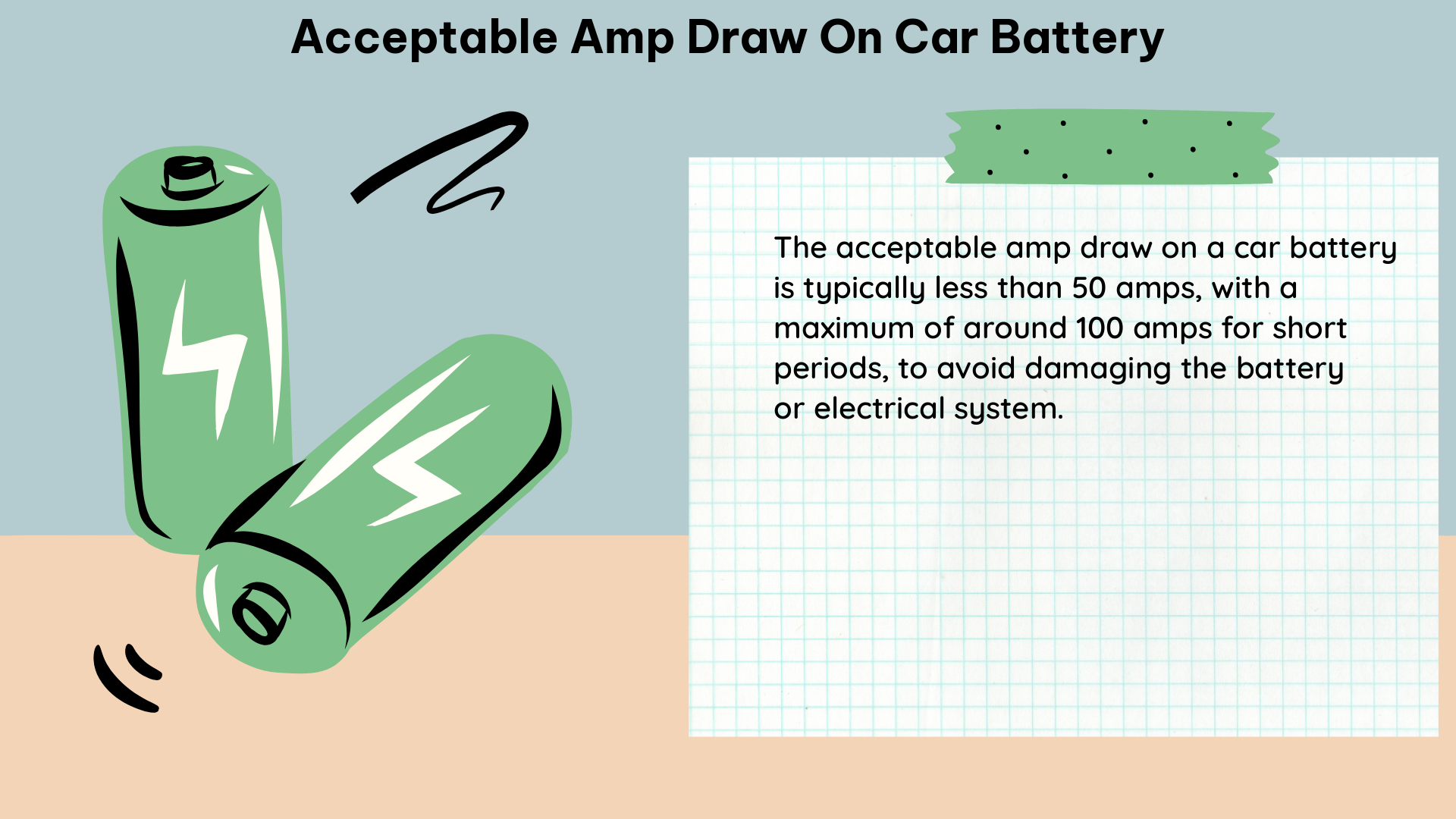The acceptable amp draw on a car battery is a crucial factor in maintaining the battery’s health and ensuring the proper functioning of a vehicle’s electrical system. This comprehensive guide will delve into the technical details, providing you with a thorough understanding of the acceptable amp draw and how to calculate it based on your specific battery and vehicle requirements.
Understanding Parasitic Draw
Parasitic draw, also known as “vampire draw,” refers to the continuous drain on a car battery even when the vehicle is turned off. This draw is caused by various electrical components, such as clocks, radios, and security systems, that remain active even in the vehicle’s off state. Monitoring and managing this parasitic draw is essential to prevent premature battery discharge and potential starting issues.
Calculating the Acceptable Amp Draw

The acceptable amp draw on a car battery depends on several factors, including the battery’s capacity, the vehicle’s electrical system, and the frequency of use. To determine the ideal parasitic draw, you can use the following formula:
Acceptable Parasitic Draw (mA) = Battery Reserve Capacity (RC) / 4
For example, if your car battery has a reserve capacity (RC) of 100 Ah, the acceptable parasitic draw would be:
Acceptable Parasitic Draw = 100 Ah / 4 = 25 mA
This calculation provides a more personalized value based on the specific capacity of your battery, ensuring that the parasitic draw does not exceed a safe level.
Factors Affecting Acceptable Amp Draw
-
Battery Capacity: The battery’s reserve capacity (RC) is a crucial factor in determining the acceptable parasitic draw. Batteries with higher RC can tolerate a higher parasitic draw without experiencing premature discharge.
-
Vehicle Electrical System: The complexity and power requirements of a vehicle’s electrical system can also influence the acceptable parasitic draw. Vehicles with more advanced features and accessories may have a higher acceptable parasitic draw.
-
Frequency of Use: The frequency of vehicle use is another important factor. Vehicles that are driven regularly, with daily use consisting of more than five to ten-minute drives, can generally tolerate a higher parasitic draw, as the alternator can maintain the battery’s charge during use.
-
Environmental Conditions: Extreme temperatures, especially in hot climates, can accelerate battery discharge and lead to sulfation, a condition where the battery’s voltage drops below 12.4 volts. In such cases, the acceptable parasitic draw may need to be lower to prevent premature battery failure.
Monitoring and Maintaining Acceptable Amp Draw
Regularly monitoring the battery’s voltage and parasitic draw is essential to ensure optimal performance and longevity. You can use a multimeter or a dedicated battery monitoring device to measure the parasitic draw and compare it to the acceptable level calculated based on your battery’s capacity.
If the parasitic draw exceeds the acceptable level, you may need to identify and address the source of the excessive draw. This may involve disconnecting electrical components, checking for faulty wiring, or seeking professional assistance from a qualified automotive technician.
Conclusion
Maintaining an acceptable amp draw on a car battery is crucial for ensuring reliable vehicle performance and prolonging the battery’s lifespan. By understanding the factors that influence the acceptable parasitic draw and regularly monitoring your battery’s condition, you can take proactive steps to keep your vehicle’s electrical system in optimal condition.
Remember, the acceptable amp draw is not a one-size-fits-all value, but rather a personalized calculation based on your battery’s capacity and your vehicle’s electrical system. By following the guidelines outlined in this comprehensive guide, you can confidently manage the acceptable amp draw on your car battery and enjoy a hassle-free driving experience.
References:
– What is ‘Normal’ for Parasitic Draw? – optimabatteries.com
– Is a .26-.27 amp draw enough to drain a battery? – Bob Is The Oil Guy
– Simple batt. drain test, [parasitic draw] – Honda Forum Discussion
– What Current Draw Is OK For Parasitic Battery Drain? – YouTube
– Advanced battery drain diagnostics – FenderBender and ABRN
– Battery Capacity and Parasitic Draw Calculation – Example Spreadsheet

The lambdageeks.com Core SME Team is a group of experienced subject matter experts from diverse scientific and technical fields including Physics, Chemistry, Technology,Electronics & Electrical Engineering, Automotive, Mechanical Engineering. Our team collaborates to create high-quality, well-researched articles on a wide range of science and technology topics for the lambdageeks.com website.
All Our Senior SME are having more than 7 Years of experience in the respective fields . They are either Working Industry Professionals or assocaited With different Universities. Refer Our Authors Page to get to know About our Core SMEs.